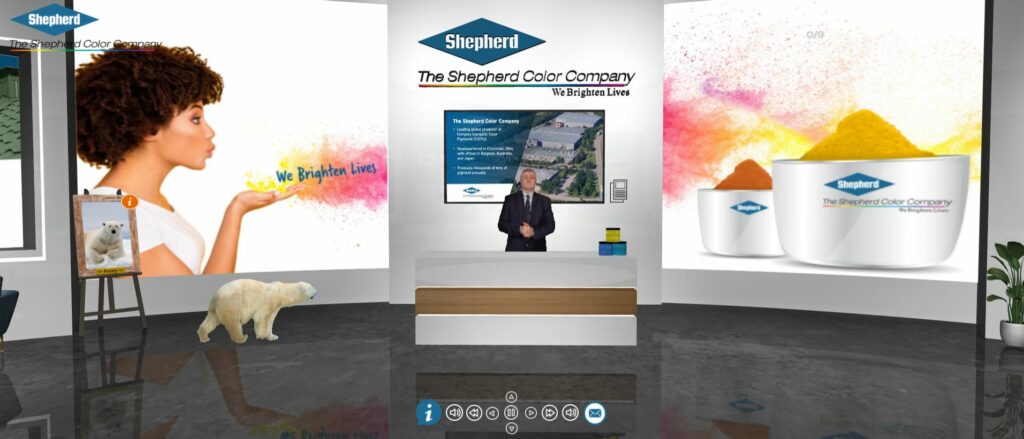Latest News
Real World Application of YInMn Blue

The recent blog post Beauty is Beyond the Eye of the Beholder used data to show the advantage of making dark blue colors that have improved IR reflectance. This blog post looks at the real world application of that technology.
Cool Roofs1 are one way to reduce the energy needed to air condition buildings. One of the hardest colors to make cool is dark blues. To show what YInMn can do to make roofs cooler we prepared two metal panels painted in the same shade of dark blue and placed them on model houses. The roof on the left is made with standard high durability pigments2 while the roof on the right based on YInMn Blue3 discovered by Oregon State's chemist Mas Subramanian. The two house models were then placed outside on a sunny, calm, warm day4 at Shepherd Color's mountain LAIR (Laboratory for Advanced Innovative Research) in the Denver, Colorado area.
When you look at the houses, you can see that they are the same visual color- a nice dark blue compared to the white houses and the dark gray platform.
The difference between the two roofs, after being exposed to the sun and allowed to stabilize in temperature, is invisible to the naked eye, but can be seen if we use an instrument that is sensitive to the far-IR wavelengths such as a FLIR® imager5. This imager turns the temperature of an object into visual information with hotter items being brighter with white being the hottest. We can even isolate the roof from the rest of the picture. As you can see, the standard version of the blue roof is getting hotter than the YInMn Blue version of the same color.
Besides this qualitative difference, we can use the FLIR® imager to quantitatively tell the difference is temperature. By looking at a composite picture in the red 'hottest' mode and using the imager's temperature sensing function, we can see that that standard blue roof is 191F(88C) while the YInMn blue roof is 168F(75C).
The temperature difference between the roofs can be explained by examining them with another instrument- a spectrophotometer in our laboratory that reports the reflectance from the visible and also the invisible near-infrared (n-IR) and ultraviolet (UV). While only a few percent of the sun's energy is in the damaging UV, roughly half of the sun's energy is in the visible part of the spectrum we use to see color, while the other half is in the invisible n-IR.
You can see that the reflectance curves are very similar in the visible (400-700nm) section of the graph since the roofs are the same color. Where they differ is in the invisible n-IR area past 700nm. Here, the standard blue and black pigments combine to make the standard dark blue have very low reflectance. Total Solar Reflectance (TSR) is used to describe how much of the sun's energy an object reflects. The higher the TSR, the more energy reflects and less energy absorbed, the cooler an object can stay. You can see that the standard dark blue has a TSR of 8 while the YInMn based blue has a TSR of 28. This 20 percent difference in TSR is what allows the YInMn Blue to stay cooler when exposed to the sun.
This concept of having lower absorption of the sun's energy (reflecting more of it away) is the idea behind the 'cool roof' programs that has been part of the EPA's Energy Star roofing program, the USGBC LEED program, California's Title 24 building codes and other codes, programs, rebates and tax incentives around the world. If roofs stay cooler, the building heats up less and less energy (and peak energy usage in the afternoon) is needed to cool a building. The YInMn Blue pigment is one part of Shepherd Color's range of Arctic® IR reflective pigments. At the core of the technology is our 'Black Rainbow' of IR reflective black pigments. Depending on your particular application there is an optimized product to help you make the coolest paint, coating, plastic, concrete or plaster for a wide range of building products.
1. A large part of the heat that enters a building comes from the roof. Adding insulation below the roof deck or venting an attic are ways to deal with this heat before it enters the living space and raises temperatures or has to be dealt with my air conditioning. To prevent the heat from ever entering the house, the roof can be made to reflect the sun's energy. This is the concept behind the move towards 'Cool Roofs'. The easiest way to do this is paint the roof white, but that is not the preferred aesthetic for steep slope roofs that are visible from ground level. People tend to like darker colored roofs. The hard part is making a dark colored roof that reflects away the heat created by the sun. The new YInMn blue makes dark blue shades possible that are highly durable and stay cooler than standard dark blue roofs.
2. Standard blue is formulated with Shepherd Color Blue 10C595 (PBl28) and a Shepherd Color Black 430 (PBk28).
3. YInMn dark blue is made with Shepherd Blue 10G513 (YInMn Blue) and Shepherd Color 30C941 (PBr29).
4. 850watt per square meter sunlight at about 85F/30C air temperature.
5. FLIR One imager for iPhone5.





